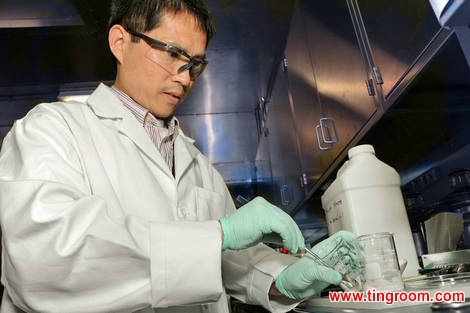英语听力文摘 English Digest 648 科学家如何研究致命的疾病
时间:2018-12-31 作者:英语课 分类:英语听力文摘 English Digest
英语课
How Do Scientists Study Deadly Diseases?
I have a trivia question for you, Don. What do the Ebola virus, anthrax, and the avian flu have in common?

图片1
Researching Disease
After all, they’re some of the most dangerous, deadly diseases around. On today’s A Moment of Science, we’re looking at a less expected link among these types of disease: the risk that’s involved in researching them.
You see, scientific research into how dangerous diseases work is an inherently risky 1 business. By increasing the amount of information that’s available about lethal 2 organisms such as anthrax, research also increases the risk of those pathogens being used for nefarious 3 purposes by bioterrorists.
Pathogens
On the other hand, though, the more we know about these pathogens, the better equipped we are to predict the risks associated with them, develop vaccines 4 that can prevent their spread, or to treat illness quickly in the case of an outbreak.
Any research that has the potential to be used toward both beneficial and destructive purposes has a special classification. It’s called “Dual Use Research of Concern,” or, DURC for short.
DURC
DURC is highly regulated. Scientists need special security clearance 5 if their work has “dual use” concern. They must have specialized 6 training, they use top notch 7 safety equipment, and their work is carefully and constantly reviewed. Most importantly, though, projects stamped with the DURC classification have to demonstrate that the potential benefits of the knowledge they will generate outweigh 8 their risks.
DURC made a lot of headlines in 2012, thanks to a group of scientists who study the avian flu. For more details about that risky research, tune 9 in next time.
科学家如何研究致命的疾病?
唐,我有个小问题想问你,埃博拉病毒、炭疽热和禽流感这些疾病有哪些共同的特点?
疾病研究
归根到底,它们是最危险、最致命的疾病。在今天的“科学一刻”节目里,我们将探索与这些疾病有关但很少被关注的联系:即研究它们所产生的风险。
众所周知,关于高危疾病的科学研究总是非常危险的。通过研究炭疽热等致命微生物,我们可以加深对这类病毒的认知,但是与此同时,这种研究也增提高了风险,因为这些致命病毒有可能被生化恐怖分子利用。
病原体
换句话说,我们对这些病原体了解得越多,我们就可以更好地应对与这些疾病相关的风险,并可以研发疫苗以预防它们的传播,或者一旦疫病大规模爆发我们可以迅速控制疫情。
如果某类研究可以同时被用于有益或者有害目的,那么这种研究有一个特殊的分类。这种类别被称为“双重用途研究”,或简称为DURC。
双重用途研究
双重用途研究的监管很严格。如果科学家的工作中有被定义为“双重用途”的,那么他们需要经过特殊的安全检查。他们必须受到特殊的训练,他们使用的是最高级别的安全设备,并且他们的工作也要接受持续细致的审查。最重要的是,被定义为“双重用途研究”的项目需要证明其产生的收益会超过所带来的风险。
2012年,双重用途研究制造了相当多的头条新闻,这要感谢那些研究禽流感的科学家团队。更多关于风险研究的资讯,请关注下期节目。
adj.有风险的,冒险的
- It may be risky but we will chance it anyhow.这可能有危险,但我们无论如何要冒一冒险。
- He is well aware how risky this investment is.他心里对这项投资的风险十分清楚。
adj.致死的;毁灭性的
- A hammer can be a lethal weapon.铁锤可以是致命的武器。
- She took a lethal amount of poison and died.她服了致命剂量的毒药死了。
adj.恶毒的,极坏的
- My father believes you all have a nefarious purpose here.我父亲认为你们都有邪恶的目的。
- He was universally feared because of his many nefarious deeds.因为他干了许多罪恶的勾当,所以人人都惧怕他。
疫苗,痘苗( vaccine的名词复数 )
- His team are at the forefront of scientific research into vaccines. 他的小组处于疫苗科研的最前沿。
- The vaccines were kept cool in refrigerators. 疫苗放在冰箱中冷藏。
n.净空;许可(证);清算;清除,清理
- There was a clearance of only ten centimetres between the two walls.两堵墙之间只有十厘米的空隙。
- The ship sailed as soon as it got clearance. 那艘船一办好离港手续立刻启航了。
adj.专门的,专业化的
- There are many specialized agencies in the United Nations.联合国有许多专门机构。
- These tools are very specialized.这些是专用工具。
n.(V字形)槽口,缺口,等级
- The peanuts they grow are top-notch.他们种的花生是拔尖的。
- He cut a notch in the stick with a sharp knife.他用利刃在棒上刻了一个凹痕。
vt.比...更重,...更重要
- The merits of your plan outweigh the defects.你制定的计划其优点胜过缺点。
- One's merits outweigh one's short-comings.功大于过。